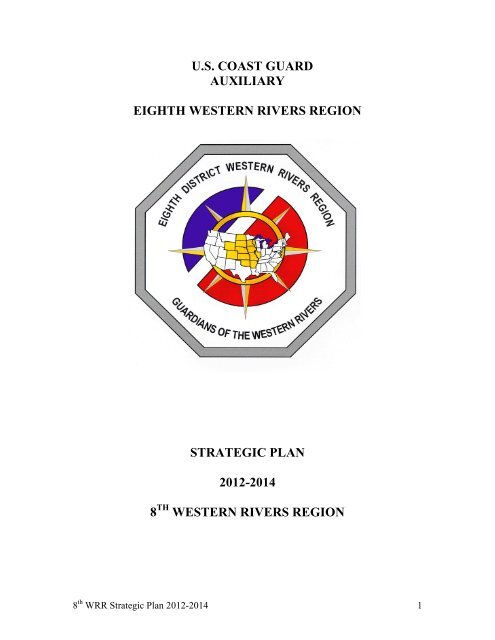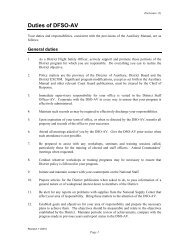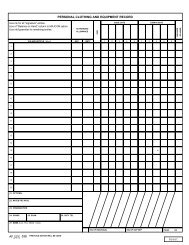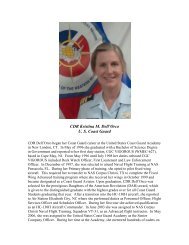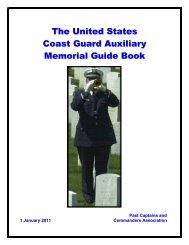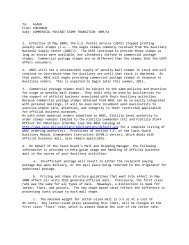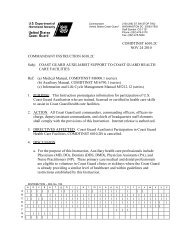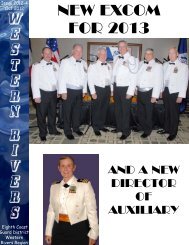us coast guard auxiliary eighth western rivers region strategic plan ...
us coast guard auxiliary eighth western rivers region strategic plan ...
us coast guard auxiliary eighth western rivers region strategic plan ...
You also want an ePaper? Increase the reach of your titles
YUMPU automatically turns print PDFs into web optimized ePapers that Google loves.
U.S. COAST GUARD<br />
AUXILIARY<br />
EIGHTH WESTERN RIVERS REGION<br />
STRATEGIC PLAN<br />
2012-2014<br />
8 TH WESTERN RIVERS REGION<br />
8 th WRR Strategic Plan 2012-2014 1
United States Coast Guard Auxiliary<br />
8 th Western Rivers Region<br />
COMM Richard L. Lawrence<br />
District Chief of Staff<br />
28 Pine Manor Drive<br />
Little Rock, AR 72207<br />
Phone: 501.663.2312 Cell: 501.690.3604<br />
Email: law28@aristotle.net<br />
To:<br />
COMMO Jim Vass, National Commodore<br />
Date: 10 Aug<strong>us</strong>t 2011<br />
Re: 8WR Strategic Plan 2012-2014<br />
In accordance with assignments of the Auxiliary Senior Officers Course, please find enclosed a<br />
draft copy of the 8 th WRR Strategic Plan.<br />
After a full review and disc<strong>us</strong>sion, it is anticipated that this Strategic Plan will be presented to the<br />
District Board for approval and implementation.<br />
Respectfully submitted,<br />
Richard L. Lawrence<br />
8 th WRR Strategic Plan 2012-2014 2
Table of Contents<br />
Cover Page………………………………………………………..1<br />
Letter of Transmittal to the National Commodore……………….2<br />
Table of Contents…………………………………………………3<br />
Executive Summary………………………………………………4<br />
Introduction……………………………………………………….5<br />
Auxiliary Policy Statement …….……………………………...... 6<br />
Mission of the Auxiliary …………………………………………7<br />
National Commodore’s Vision…………………………………...7<br />
National Strategic Imperatives……………………………………7<br />
Desired Outcomes…………………………………………………8<br />
Summary of District Assessments (SWOT)………………………9<br />
District Strategic Issues………………………………………….19<br />
District Goals and Strategies to Accomplish These Goals……....22<br />
Division/Flotilla Objectives ……………………………………..24<br />
Division/Flotilla Action Plans …………………………………..25<br />
Attachments…………………………………………………….. 26<br />
8 th WRR Strategic Plan 2012-2014 3
DISTRICT VISION STATEMENT<br />
EXECUTIVE SUMMARY<br />
The Auxiliary members of the 8 th Western Rivers Region (8 th WRR) will continue to<br />
remain efficient, qualified and vigilant in all aspects of their Coast Guard Auxiliary<br />
career. All members are expected to adhere to the core values of Honor, Respect, and<br />
Devotion to Duty.<br />
Over the past several years, the Auxiliary has encountered numero<strong>us</strong> changes which are<br />
intended to improve the Auxiliary’s mission to support the civil missions of the Coast<br />
Guard. While these changes have not always been embraced with enth<strong>us</strong>iasm, reflection<br />
and understanding of the underlying missions enable the members to accept the changes.<br />
As always, members m<strong>us</strong>t constantly balance the missions with the demands of personal<br />
life.<br />
The leadership of the 8 th WRR will execute their duties with Integrity, Responsibility and<br />
Accountability:<br />
Integrity: All Auxiliary participation will be undertaken with the upmost honesty,<br />
unity and an adherence to a strong code of values.<br />
Responsibility: All Auxiliary participants will be reliable, tr<strong>us</strong>tworthy and willing<br />
to meet any obligations agreed to, and will faithfully execute their duties and abide by the<br />
governing policies established by the Commandant of the United States Coast Guard.<br />
Accountability: All Auxiliarists will be answerable for their conduct; exercising<br />
solid, j<strong>us</strong>tifiable and considered judgment.<br />
DISTRICT MISSION STATEMENT<br />
Our mission as Coast Guard Auxiliarists comprises the following:<br />
Help to create a safe, secure, and enjoyable boating experience for the recreational<br />
boating public by providing programs that aid in the minimization of personal injury and<br />
property damage;<br />
Assist with marine safety, environmental and national security efforts as<br />
requested by the active duty Coast Guard;<br />
Recruit and train new Auxiliary members; and,<br />
Energize all members to do the Right Things Right while serving with Integrity,<br />
Responsibility and Accountability.<br />
8 th WRR Strategic Plan 2012-2014 4
INTRODUCTION<br />
The foc<strong>us</strong> of preparation for this Strategic Plan was to conduct a SWOT analysis<br />
(Strengths, Weaknesses, Opportunities and Threats) and then, <strong>us</strong>ing the results of the<br />
responses, to develop the District <strong>plan</strong> to adhere to the National Mission Statement and to<br />
align the <strong>plan</strong> with the National Commodore’s Vision Statement. The Divisions and<br />
Flotillas in the 8WR District will be asked to incorporate this <strong>plan</strong> into their unit action<br />
items.<br />
To be successful, the 8 th WRR needs to fully understand the SWOT responses that were<br />
received from the District Board and staff officers and devise a <strong>plan</strong> that is workable. To<br />
achieve the <strong>plan</strong>, there m<strong>us</strong>t be communication between the District elected and<br />
appointed officers to the Divisions/Flotillas. Maintaining the two-way flow of<br />
information is critical to understanding the goals as well as having a shared ownership<br />
among the parties. Without this ownership, the likelihood of achieving smooth working<br />
relationships and the accomplishments sought will be difficult.<br />
The 8 th Western Rivers Region Auxiliary District consists of sixteen states which include<br />
Arkansas, Colorado, Iowa, Kansas, Missouri, Nebraska, North Dakota, Oklahoma, South<br />
Dakota and Wyoming, as well as portions of Illinois, Louisiana, Minnesota, Mississippi,<br />
Tennessee and Wisconsin. Those 16 states go generally from the Mississippi River to<br />
the Rockies and from the top of Louisiana to the Canadian border. Ten of those states<br />
encompass over 784,000 sq miles while the area of the other six states within the 8 th<br />
WRR has over 348,000 sq. miles.<br />
The membership consists of over 1800 volunteers in 82 flotillas, 4 detachments within 12<br />
divisions. Members participate in a variety of missions ranging from public education<br />
and vessel safety checks to safety patrols by both surface and air facilities. Members also<br />
engage in other missions authorized by the Commandant of the United States Coast<br />
Guard. During 2010, members of the 8 th WRR completed over 25,000 missions and<br />
recorded nearly 244,000 hours in support of the Coast Guard. The work of Auxiliary<br />
members is the equivalent to the work of 144 full time people.<br />
8 th WRR Strategic Plan 2012-2014 5
AUXILIARY POLICY STATEMENT<br />
8 th WRR Strategic Plan 2012-2014 6
The Mission of the U.S. Coast Guard Auxiliary<br />
The primary mission of the U.S. Coast Guard Auxiliary is Recreational Boating Safety. We<br />
also have the mission to contribute to the safety and security of our citizens, ports,<br />
waterways, and <strong>coast</strong>al <strong>region</strong>s, as authorized by the Commandant of the United States Coast<br />
Guard. We will support the overall mission by improving the quality and delivery methods<br />
of our educational products. We will work with other like-minded organizations to improve<br />
the overall knowledge of the boating public to increase awareness of safety on the water.<br />
National Commodore’s Vision Statement<br />
The Coast Guard Auxiliary will continue to meet America's ever changing needs<br />
through increased attention to recreational boating safety, security of America’s<br />
waterways and improved methods of educating the boating public.<br />
National Strategic Imperatives<br />
• Continue to be the best all volunteer organization in the Nation (Goal 1)<br />
• Continue to provide the best product on the market for the education of the boating<br />
public (Goal 1)<br />
• Maintain the high standards of the organization to insure that we continue to maintain<br />
the integrity and dependability of the organization (Goal 1)<br />
• Maintain a ready volunteer force ready to assist the Coast Guard in times of emergency<br />
(Goal 2)<br />
• Continue an aggressive recruiting program to include a diversity of members to insure<br />
the long-term growth of the organization (Goal 2)<br />
• Continue to recognize the contributions of our members (Goal 2)<br />
• Continue to meet the expectations of the Coast Guard and America’s Boating Public to<br />
be the premiere safe boating organization (Goal 3)<br />
• Work with other Federal Government Agencies, States and other partner agencies to<br />
support safe boating (Goal 3)<br />
• Adj<strong>us</strong>t our organization to the changes in the structure of the Coast Guard to best<br />
support its missions and to allow for the cooperation within to insure the organization<br />
operates at peak efficiency (Goal 3)<br />
• Create innovative methods to <strong>us</strong>e new electronic systems to improve the overall<br />
effectiveness of the education process (Goal 4)<br />
8 th WRR Strategic Plan 2012-2014 7
DISTRICT’S DESIRED OUTCOMES<br />
1. Consistent with the National Mission Statement, maintain a balance of<br />
promoting and improving recreational boating safety, and supporting the<br />
homeland security efforts while providing support to the Coast Guard<br />
operational, administrative and logistical requirements.<br />
2. Improve all training programs <strong>us</strong>ing new methods and district wide <strong>us</strong>e<br />
of computer based programs.<br />
3. Have communications between all levels so that all members know what<br />
is going on.<br />
4. Encourage leaders to recognize the contributions of each member at the<br />
flotilla and division meetings.<br />
5. Increased interdivisional activities to network and share resources.<br />
6. Increase partnering with the active duty units near our division locations<br />
7. Encourage and support every member with specific emphasis on new<br />
members to become qualified and active in a program or programs of<br />
their choice.<br />
8. Develop viable recruiting of new members.<br />
8 th WRR Strategic Plan 2012-2014 8
SUMMARY OF DISTRICT ASSESSMENTS<br />
SWOT ANALYSIS<br />
SWOT (Strengths, Weaknesses, Opportunities and Threats) inputs were solicited from<br />
the District Board and District Staff Officers.<br />
Operations / Service Delivery<br />
STRENGTHS<br />
1. Viable & attainable crew/coxswain/PWO/Airboat/Aircraft training<br />
2. Excellent Highly Qualified/Trained Dedicated Individuals;<br />
Coxswains, boat crew, Aviators, Air Crew, VEs, RBSVP, Trident, etc.<br />
3. Many Auxiliarists volunteer many hours (almost every weekend over<br />
the summer) in Auxiliary and Coast Guard Missions.<br />
4. Opportunities for training<br />
5. Basic financial support for operations - fuel, PPE<br />
6. OPFacs can be deployed on short notice (surface & Aviation)<br />
7. Large number OpFacs of vario<strong>us</strong> sizes and specifications.<br />
8. Auxiliarists willing to go where they are needed within the District as<br />
well as to other Districts (i. e Katrina, Horizon Deep Water).<br />
9. Acceptance of the Auxiliary by the Active Coast Guard as a member<br />
of the team and a realization that a volunteer workforce can contribute<br />
to the overall mission of the Coast Guard.<br />
10. Increased emphasis on communications between and among<br />
Auxiliary units.<br />
11. Increased relationships with other agencies.<br />
12. Auxiliary is still attracting members for service to the Coast Guard<br />
and the US following the events of 9/11. The core value of devotion to<br />
duty remains evident.<br />
Human Resources<br />
1. Strong nucle<strong>us</strong> of dedicated, knowledgeable members<br />
2. Many members are retired allowing increased participation as<br />
Auxiliary members.<br />
8 th WRR Strategic Plan 2012-2014 9
3. Age and experience of senior members provided high quality of<br />
instructors and leaders.<br />
4. Members are accepting the new emphasis on diversity and are<br />
encouraging recruiting in bi-cultural areas. Divisions are actively<br />
engaged in helping weak flotillas grow and prosper.<br />
5. More contact with local Coast Guard units has increased knowledge<br />
of the Auxiliary and aids in recruitment of members.<br />
6. General emphasis on recruiting.<br />
7. The diversity in district is widespread with many professions and<br />
occupations represented. In general the Midwest is known for its work<br />
ethic.<br />
8. Members who are interested in supporting the Coast Guard.<br />
9. Members who are willing to devote large amounts of their time and<br />
personal funds to attend meetings, take training, and study on their own.<br />
10. Members who strive to complete missions that were tasked to them.<br />
11. Intellectual capacity due to the variety of experiences and<br />
knowledge and diverse backgrounds of the membership.<br />
12. Many new members are joining without boats, but with skills in<br />
other areas such as computer operations, ham radio skills, flying, writing<br />
and public affairs.<br />
Organizational Management<br />
1. Strong leadership; information <strong>us</strong>ually distributed along proper<br />
channels. Continued efforts to ensure information flow.<br />
2. Many members have considerable management and organizational<br />
skills.<br />
3. Many quality leaders<br />
4. The chain of command from District down to Flotilla has consisted<br />
of intelligent, dedicated elected and appointed officers willing to<br />
devote much time and skill in supporting the Auxiliary missions.<br />
5. Many younger competent members who are willing to devote the<br />
time, effort and funds to assume management positions.<br />
8 th WRR Strategic Plan 2012-2014 10
6. A reasonably sound management structure.<br />
7. The structure of the district allows for effective and efficient<br />
communication between all levels of the organization.<br />
8. Training for Flotilla and Division Commanders is well received.<br />
Technology / Facilities<br />
1. Electronic study materials/manuals readily available<br />
2. Excellent <strong>us</strong>er friendly district website<br />
3. The vast majority of Auxiliarists now <strong>us</strong>e computers<br />
4. The number of radio facilities and operators has increased.<br />
5. Internet based programs such as AUXDATA and POMS, together<br />
with the ability to fill out and transmit vario<strong>us</strong> forms on line has<br />
aided in better management of programs.<br />
WEAKNESSES<br />
Operations / Service Delivery<br />
1. Insufficient <strong>us</strong>e of our radio operators during normal operations.<br />
2. Many of our operational facilities are confined to one body of<br />
water.<br />
3. Mentorship program not fully developed or utilized<br />
4. Fewer qualified crew members reflect the need to recruit younger<br />
members who either have boats or can quickly qualify as boat crew.<br />
5. Poor communication between Auxiliary levels.<br />
6. Poor coordination with Coast Guard due to timing and distance.<br />
7. OpFacs are mostly in a non-operational stat<strong>us</strong> in winter months,<br />
limiting operations.<br />
8. Fewer members own boats due to the high cost of purchasing and<br />
maintaining them.<br />
9. Aging membership.<br />
8 th WRR Strategic Plan 2012-2014 11
10. Distances between OpFacs and boat crews limit response time in<br />
an emergency<br />
11. Mission hours are reaching maximum output as number of<br />
qualified members decrease.<br />
12. Significant administrative time is required with Sector Upper Miss.<br />
River due to sector policies.<br />
Human Resources<br />
1. Auxiliarists possess a great variety of skills that are not matched<br />
with assignments.<br />
2. Some staff positions have an extreme amount of paper work to do.<br />
3. Units still tend to form cliques and do not include all available<br />
members/resources when responding to a situation<br />
4. Loss of valuable knowledge and sense of tradition with increasing<br />
death rate of members.<br />
5. Many members have jobs, families and other volunteer<br />
commitments which do not allow for volunteer work that requires their<br />
time away from home (especially on weekends).<br />
6. Difficulty in recruiting; we are not getting the ‘baby boomers.’<br />
7. Lack of commitment among some members; some members are<br />
dues payers only.<br />
8. Variability of schedules among volunteers<br />
9. Lack of needed training<br />
10. Other volunteer commitments to compete for the time of<br />
members.<br />
11. Lack of permanent mentors for new members. If every new<br />
member had a permanent mentor (not j<strong>us</strong>t for 90 days) this might get<br />
them more involved.<br />
12. Reluctance of some members to complete paperwork in a timely<br />
fashion.<br />
8 th WRR Strategic Plan 2012-2014 12
13. Reduced credibility with active duty due to some of our members<br />
failing to complete a mission that the member had accepted.<br />
Organizational Management<br />
1. Education requirements for certain positions limit the availability<br />
of people for those situations.<br />
2. Lack of communication between District, Division, & Flotilla.<br />
3. Need more of our dynamic members, possessing current or<br />
previo<strong>us</strong> management/administrative experience, to seek election.<br />
4. Older executives should return to their flotillas and serve as valued<br />
senior mentors to the new membership j<strong>us</strong>t joining. Their previo<strong>us</strong><br />
leadership experience would become a valuable asset to any unit in the<br />
Auxiliary.<br />
5. Chain of Leadership/Management may hinder communication<br />
6. Few opportunities for interaction with tactical and <strong>strategic</strong> levels<br />
while major foc<strong>us</strong> in on flotilla activities.<br />
7. Organizational management lacks uniformity due to available time,<br />
volunteer organization, travel time, and budgets.<br />
8. Too many layers of management. Too far from the bottom to the<br />
top mainly in the Staff areas. Some staff officers do great work and<br />
others do little or nothing.<br />
9. Lack of continuity of communications with staff officer positions.<br />
10. Too much time required to process a new member through<br />
security.<br />
11. Some elected officers are not attending required meetings.<br />
12. Damage reimbursement procedures that are cumbersome and slow.<br />
Technology / Facilities<br />
1. Too technology dependent and sometimes lose sight of the simple<br />
way around a situation.<br />
2. Average age of membership indicates resistance to technology.<br />
3. Electronic manual decreases hands-on study capability<br />
4. Unrealistic expectation of printing study materials/manuals.<br />
8 th WRR Strategic Plan 2012-2014 13
5. The lack of centrally located conference meeting areas increases the<br />
high cost of conferences to those members who are not funded.<br />
6. Facilities count per flotilla has decreased.<br />
7. Insufficient updating of web-based materials (expired links, outdated<br />
materials, difficulty in locating items); poor supporting materials for some<br />
courses<br />
8. The district lacks inter-agency communications, including federal and<br />
state.<br />
9. AUXDATA is difficult for the semi-competent computer <strong>us</strong>ers to<br />
navigate through. The more accomplished “computer competent” may<br />
find it easier to <strong>us</strong>e, but fr<strong>us</strong>trating.<br />
10. AUXDATA controls can restrict flexibility.<br />
11. Restriction on “C” School attendance for AUXDATA/IS is too<br />
restrictive. As a person advances in leadership he or she is going to need<br />
the education to properly run divisions and higher organizations.<br />
12. Not all members have electronic capabilities (i.e. E-mail, Internet<br />
access to request orders from POMS)<br />
13. POMS – in the past “unscheduled” downtime for maintenance (ca<strong>us</strong>ing<br />
members sometimes days before they were able to access the system to<br />
either request or complete orders) – updates should be tested on a back up<br />
site before being rolled out to the general public – better communication of<br />
how the changes affect the <strong>us</strong>er – system should have a redundant back up<br />
site in case of primary system failure.<br />
Opportunities<br />
Service Expectations<br />
1. Augment the CG regulars and assist other organizations in times of<br />
need.<br />
2. Coast Guard Recruiters source of new members.<br />
3. Boating clubs, sporting goods stores are sources for membership.<br />
4. Boater safety education allows interaction and prospects.<br />
8 th WRR Strategic Plan 2012-2014 14
5. Public Affairs to get Auxiliary better known<br />
6. Ability to render assistance due to unified command.<br />
7. Other agencies requesting assistance due to improved<br />
capabilities/equipment/resources.<br />
8. Coordination with outside agencies for Flotilla and Divisions<br />
Physical Resources<br />
1. Aging of membership allows work in areas other than the more<br />
demanding patrol areas.<br />
2. There are potential members out there waiting to be asked.<br />
3. Need ability to utilize gain assets that are disposed by other<br />
organizations/agencies but are in good working condition and can be<br />
utilized by the <strong>auxiliary</strong><br />
4. Software and computer technology availability<br />
5. Young adults looking at joining to fulfill their patriotic drive.<br />
Readiness Capability<br />
1. Many Auxiliarists are ready to serve but are underutilized.<br />
2. Younger current members and incoming younger members need to<br />
be trained in skills that are required to meet Coast Guard standards<br />
3. Could benefit from developing a training program to handle<br />
emergency responses.<br />
4. Influx of entities willing to donate assets and funds needed to render<br />
assistance.<br />
5. Notify outside agencies of Auxiliary programs and assets available to<br />
them.<br />
Technology<br />
1. Exposure to Coast Guard systems, training, and methods.<br />
2. Informed instructors to educate our members in the current<br />
technology required to assist the Coast Guard.<br />
3. Expanded <strong>us</strong>e of advancing methods to support communication and<br />
training (WebEx /GoToMeeting)<br />
8 th WRR Strategic Plan 2012-2014 15
4. Diversity of membership allows for more advanced <strong>us</strong>e of<br />
technology.<br />
5. Better and more efficient computer programs to reduce the level of<br />
input.<br />
6. Advancement in research and development creating<br />
enhancements/improvements to search and rescue technology (better<br />
GPS positioning, cell phones transmitting GPS coordinates)<br />
7. Beta test non-law enforcement technology to assist in developing<br />
better SAR and surge operations equipment.<br />
8. Working relationship with outside agencies such as Boat and Motor<br />
mfg. (Mercury, Yamaha, Skipperliner, and Wellcraft, as a benefit for<br />
members in areas of product and repair / maintenance.<br />
Economic Readiness<br />
1. Need more access to corporate, commercial marine, insurance<br />
companies, Govt.<br />
2. Emphasis on grants for vario<strong>us</strong> programs.<br />
3. Members need to be fully informed of the direct correlation between<br />
the recording of time and money donations to the level of support that<br />
can be expected from the Coast Guard. “If the time is not recorded<br />
(7029 or 7030), the Auxiliary does not get any credit”<br />
Threats<br />
Service Expectations<br />
1. Lack of resources (boats, money)<br />
2. Increased training requirements that put the Auxiliary on the level of<br />
active duty forces without regard for the age and experience of the<br />
Auxiliary results in loss of members and negative attitudes.<br />
3. Operations programs will suffer due to high cost of boats. This will<br />
lead to fewer new and younger members having boats available.<br />
4. The public expects help from the Auxiliary and don’t understand the<br />
requirements and procedures to follow (MARBs, etc.)<br />
8 th WRR Strategic Plan 2012-2014 16
5. Local government expectations of assistance when there may be<br />
jurisdictional issues.<br />
6. Potential mission becoming more increasingly law enforcement or<br />
security based<br />
7. Need to have general terrorism education<br />
Physical Resources<br />
1. District is large in geographical size.<br />
2. Lack of funding to Auxiliary with increasing demands has personal<br />
impact on members leading to further decay in membership and make<br />
recruiting more difficult.<br />
3. Budgetary problems in Congress for Coast Guard programs to flow to<br />
the Auxiliary.<br />
4. Other volunteer organizations better suited to fulfill prospective<br />
member’s needs.<br />
5. Donations becoming scarce as agencies do not replace or upgrade<br />
their existing assets.<br />
6. Drop in volunteerism<br />
7. Many Auxiliarists are not qualified to serve in all situations.<br />
Readiness Capability<br />
1. Distances involved in seeking training.<br />
2. Increased need to offer general readiness capability training to<br />
qualified members prior to any deployment.<br />
3. Lack of training; lack of consistency<br />
4. External policy changes and requirements for boat crew.<br />
5. Employers unwilling to permit Auxiliarists time off to respond to<br />
emergencies<br />
6. Not all assets available to respond quickly.<br />
7. Lack of public knowledge of the need for members carry out<br />
Auxiliary programs.<br />
8 th WRR Strategic Plan 2012-2014 17
8. Age and lack of physical conditioning could be a limiting factor in<br />
some cases, but 8WR could still be a viable asset as a force multiplier<br />
due to the large number of Auxiliarists in our district.<br />
Technology<br />
1. Training issues. Some courses are antiquated and are not germane<br />
any more.<br />
2. Inability to keep up with technology; obsolescence<br />
3. Getting computer access and interface<br />
4. Systems such as POMS m<strong>us</strong>t be more reliable and <strong>us</strong>er friendly<br />
5. Communications in a national disaster would be difficult.<br />
6. New equipment/technology becoming increasingly more expensive to<br />
the point that it may be out of means to the average Auxiliarist.<br />
7. Technology changing faster than the <strong>auxiliary</strong> is able to adapt to or<br />
incorporate<br />
Economic Readiness<br />
1. Auxiliarists are expected to front expense and then wait for<br />
reimbursement.<br />
2. Limited resources provided by Coast Guard.<br />
3. Equipment sometimes not where it needs to be.<br />
4. Raising dues is not the way to economic readiness.<br />
5. Members m<strong>us</strong>t first protect their families in an emergency, and then<br />
consider others.<br />
8 th WRR Strategic Plan 2012-2014 18
DISTRICT STRATEGIC ISSUES<br />
Response<br />
Communications:<br />
Coast Guard and Auxiliary HF communications capabilities (fixed and mobile)<br />
Coast Guard and Auxiliary back up communications capabilities (HF, VHF)<br />
Coast Guard and Auxiliary communications compatibility<br />
Communications interface with federal and local Emergency Management<br />
Agencies<br />
Qualifications:<br />
Operations:<br />
Aviation:<br />
Implementation of Coast Guard Policy for Coxswain qualification/re-qualification<br />
(i.e. towing policy, SAR policy, etc.)<br />
Consistency of Qualification Examiner efforts across large geographic areas<br />
Standardization of patrol routines<br />
Standardization of patrol reporting (i.e. SAR Reports, voice reports, etc.)<br />
Standardization of procedures between Sector Upper Mississippi River & Sector<br />
Lower Mississippi River. There are areas in the District that do not<br />
resemble the Mississippi, Missouri or Arkansas Rivers where there are<br />
radio repeaters and the crews can contact the sector by radio. There are<br />
areas in the District where cell phones do not work and the only VHF<br />
radio contact is another of our boats or our local ground based radio<br />
station. Need to be mindful what works near the Sectors does not<br />
necessarily work in Shell Knob, Missouri or in Oklahoma.<br />
Time between overhaul (TBO) maintenance<br />
Contingency <strong>us</strong>e of aviation assets (including aircrew)<br />
Limited numbers of aviation assets & aircrews<br />
8 th WRR Strategic Plan 2012-2014 19
Prevention<br />
State Liaison:<br />
Consistent training of state liaison officers<br />
Standards of interaction with State Agencies<br />
Advocacy for state agencies to Coast Guard instead of the reverse.<br />
Public Education:<br />
Area coordination of public education classes<br />
Foc<strong>us</strong> of public education training (multi-day courses vs. one day courses)<br />
Aids to Navigation:<br />
Consistent Auxiliary support to USCG river tenders<br />
Completion of aid verification<br />
Qualification process and numbers of aid verifiers<br />
Member Training:<br />
Low numbers and percentage of Auxiliarist completing AUXOP qualification<br />
Limited mentoring process<br />
Limited Auxiliary participation in Trident qualification process<br />
Program Visitor:<br />
Lack of emphasis among divisions<br />
Limited numbers of Auxiliarists qualified as program visitors<br />
Vessel Examination:<br />
Communication of major changes to boating examination program (e.g. changes<br />
in laws that affect certification).<br />
Strategic <strong>us</strong>e of the Boating Accident Reporting Database (BARD):<br />
Develop <strong>strategic</strong> <strong>plan</strong> to target RBS trouble spots in division AOR <strong>us</strong>ing data in<br />
BARD.<br />
8 th WRR Strategic Plan 2012-2014 20
Logistics<br />
Personnel Services:<br />
Finance:<br />
Publication:<br />
Plan for active recruiting of new members<br />
Tools for recruiting<br />
Lack of Feedback from successful recruiters to the District<br />
Leadership forum for disc<strong>us</strong>sion of basic issues<br />
Long term financial <strong>plan</strong> for District<br />
Electronic vs. paper<br />
Communications Services:<br />
Materials:<br />
Continued <strong>us</strong>e of electronic tools for members<br />
None<br />
Information Services:<br />
Public Affairs:<br />
Updates to IS officers to enter changes in AUXDATA/AUXINFO<br />
District wide public affairs campaign for recruiting/public education/etc.<br />
Coordination of district message to media<br />
8 th WRR Strategic Plan 2012-2014 21
DISTRICT GOALS and STRATEGIES TO ACCOMPLISH THESE GOALS<br />
1. Support the Commandant’s Auxiliary Policy Statement priorities.<br />
Strategy to Accomplish: Leadership will communicate with the membership to be sure<br />
all members have and understand the Commandant’s Auxiliary Policy.<br />
2 Improve overall training programs to utilize developing methods and to<br />
encourage district wide <strong>us</strong>e of computer based programs.<br />
Strategy to Accomplish: Leadership knowledge of and emphasis on current training<br />
opportunities and p<strong>us</strong>h for more effective delivery methods.<br />
3 Improve communications at all levels from the top down and the bottom up, so<br />
that all members know what is going on at all levels.<br />
Strategy to Accomplish: Encourage <strong>us</strong>e of electronic means to keep members informed<br />
and to allow both elected and staff officers to become more involved<br />
4 Encourage leaders to recognize the contributions of each member at the flotilla<br />
and division meetings.<br />
Strategy to Accomplish: Leadership m<strong>us</strong>t stress the need for elected and appointed<br />
officers to acknowledge the efforts of members and to take active steps to reward those<br />
efforts.<br />
5 Encourage interdivisional activities when feasible to network and share<br />
resources.<br />
Strategy to Accomplish: Leadership will work with separate divisions to <strong>plan</strong> for<br />
collective activities in order to interact with others, train and socialize together which<br />
should result in more teamwork across the district.<br />
6 Increase partnering with the active duty units near our division locations<br />
Strategy to Accomplish: Encourage the members where possible to work more closely<br />
with the local Coast Guard Units.<br />
7 Encourage and support every member with specific emphasis on new members to<br />
become qualified and active in a program or programs of their choice.<br />
Strategy to Accomplish: Encourage expanded <strong>us</strong>e of mentors and leadership to work<br />
with new members as well as energize older members to become involved again<br />
8 th WRR Strategic Plan 2012-2014 22
8 Develop viable recruiting for new members.<br />
Strategy to Accomplish: Leadership m<strong>us</strong>t review existing recruiting <strong>plan</strong>s, determine<br />
what is or is not working, and make changes as needed. Recruiting <strong>plan</strong>s would be<br />
shared with divisions and flotillas. Continued monitoring of the <strong>plan</strong> would be critical to<br />
emphasize the importance of the <strong>plan</strong>, provide support and consider modifications as<br />
might be required.<br />
8 th WRR Strategic Plan 2012-2014 23
DIVISION/FLOTILLA OBJECTIVES<br />
To be developed<br />
8 th WRR Strategic Plan 2012-2014 24
DIVISION/FLOTILLA ACTION PLANS<br />
To be developed<br />
8 th WRR Strategic Plan 2012-2014 25
Attachments<br />
8 th WRR Strategic Plan 2012-2014 26


